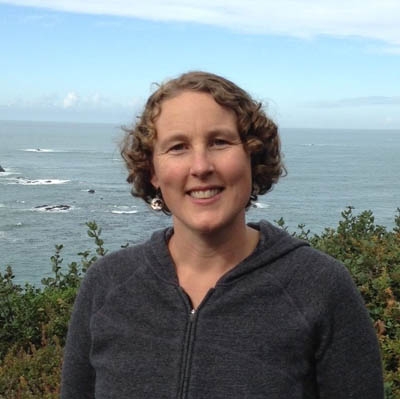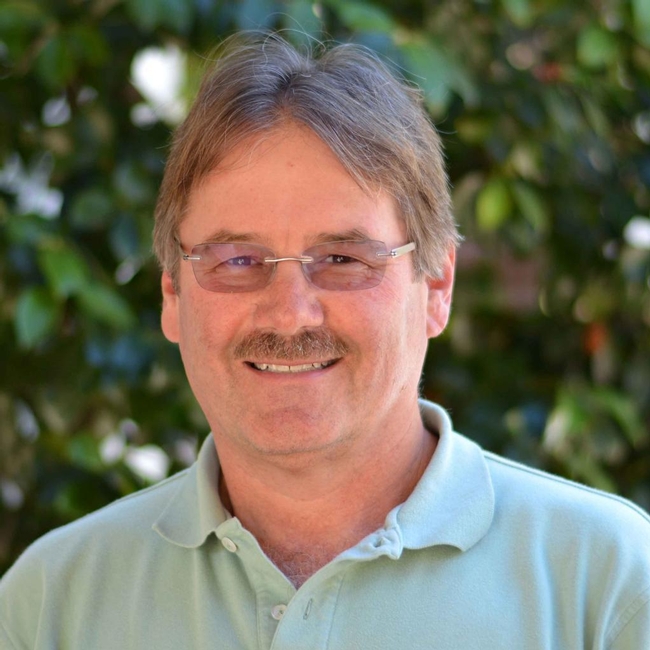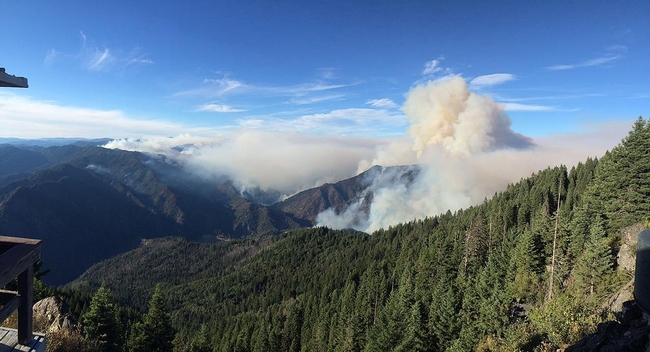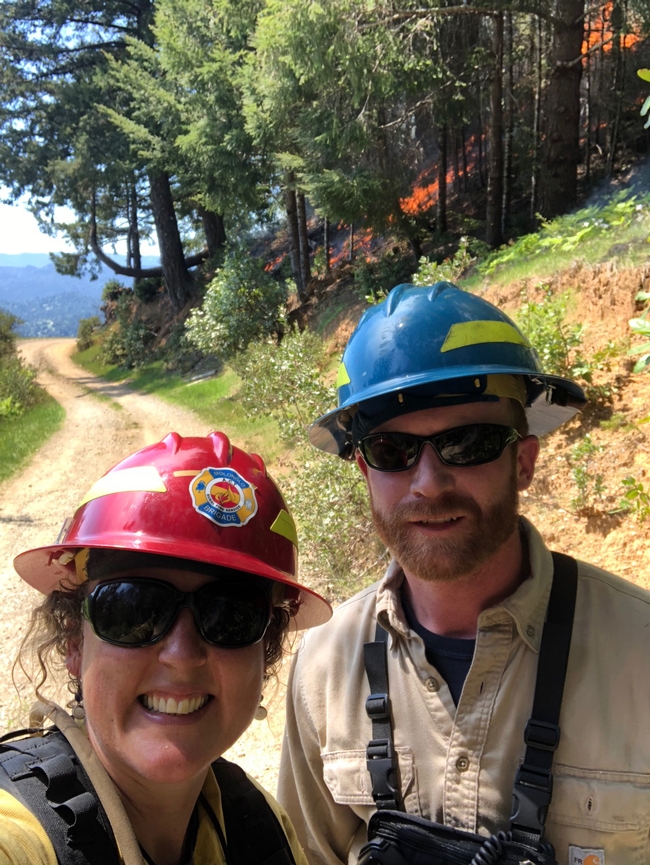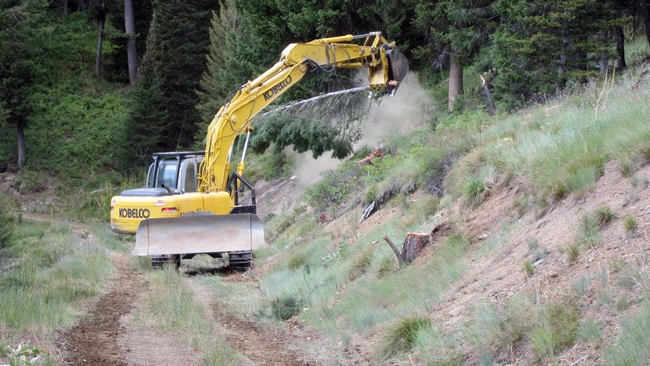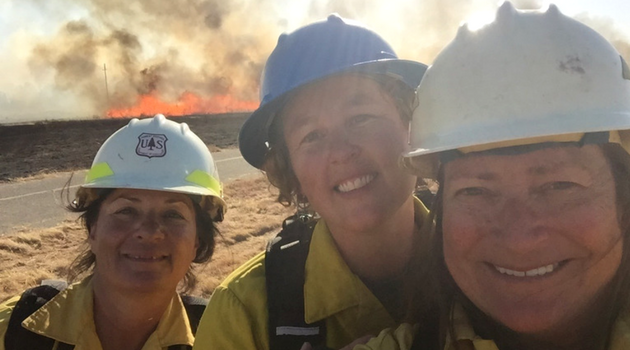Posts Tagged: Lenya Quinn-Davidson
North Coast forests are more dense and dry, fueling fires
Five of California's six largest fires have occurred in 2020, reported Julie Cart in CalMatters.
“There is a collective sensation that we are reaching a tipping point,” said Lenya Quinn-Davidson, a fire specialist with the University of California Cooperative Extension. “This year was not just the fluke burning horrifically. This is 3.2 million acres of fire that burned in a month.”
Quinn-Davidson is based in Humboldt County, with typically rainy, foggy redwood forests. However, she said, the forests don't resemble their former state.
"They are suffering from the same things that the rest of the state forests are. They are poorly managed and have fuels buildup," Quinn-Davidson said.
Redwood and pine forests are many times more dense than at any time in their history.
"We are now entering a new regime, the climate is changing and we are seeing drier conditions and we are seeing a longer fire season. We are not getting that fall precipitation," she said.
The state's 2018 Fourth Climate Assessment included dire predictions for the North Coast: “Future wildfire projections suggest a longer fire season, an increase in wildfire frequency, and an expansion of the area susceptible to fire.”
Average annual maximum temperatures in Mendocino, Humboldt, Del Norte, Lake, Trinity and Siskiyou Counties could increase by as much as 9 degrees through the end of the century, the report concluded.
“The weather and climate is impacting these areas. Last year we were at 60% of average precipitation. We're drier than normal,” said Scott Stephens, a fire scientist at UC Berkeley. “So when lighting strikes, you get an overwhelming number of ignitions in fuels that have been preconditioned to burn.”
The fog that reliably blankets the North Coast is dissipating. Research from UC Berkeley found that fog frequency has declined by a third compared with a century ago.
“Even here in Humboldt County — we are right on the ocean, basically in a rainforest — people are starting to look around and say, ‘Is my house ready for a wildfire?' I'm hearing those conversations,” Quinn-Davidson said.
UCCE experts provide scientific fire information to media
The raging fires sparked during August have raised the visibility of UC fire scientists, who provide critical information to state and national media. Below are a sampling of stories and comments offered by UC Cooperative Extension experts:
Forest management needed
“When we started suppressing fires 100 years ago all the time, we actually allowed a huge buildup of fuels and debris,” said UC Cooperative Extension forest advisor Susie Kocher, who is based in the Lake Tahoe region.
She is an advocate for requiring residents to clean up the extra fuel — grasses, trees, shrubs and clutter — around their homes, making them fire ready, and for more prescribed burns.
“There's a need for more frequent, low-severity fire across the landscape, so that we wouldn't have quite so much explosion in the burning in the fields that we have currently,” Kocher said.
In August, the state and federal government agreed to clean up 1 million acres by 2025, with practices such as prescribed burns. Part of that agreement also included a commitment to create a 20-year plan by next year to prioritize areas for forest-thinning. But even this plan is sliver of what's needed to protect California from devastating future wildfires.
“I think it's a good indication they're paying attention now and that we're moving in the right direction,” said Michael Jones a UC Cooperative Extension forestry advisor in Mendocino, Lake and Sonoma counties. “My hope is that once we start with a million, then it's really easy to scale up to multiple millions.”
Capitol Public Radio, Sept. 3, 2020Taking steps to reduce fire danger
“There are things that we can and should be doing to address the fire problem and fire risk in California, and to get ahead of it, and to make ourselves more resilient,” said Lenya Quinn-Davidson, a fire advisor with the University of California Cooperative Extension and director of the Northern California Prescribed Fire Council.
Quinn-Davidson said she was encouraged when California Gov. Gavin Newsom and U.S. Forest Service officials announced an agreement this month on a joint strategy to reduce wildfire risks.
“We need more coordination and more collaboration among all of the different groups who work on these issues,” Quinn-Davidson said. “The number one thing we need is more coordinated vision around what fire is going to look like in California, how people can live with fire.”
Arizona Central, Aug. 28, 2020
What's at stake
“Every part of California is receptive to wildfire,” said Yana Valachovic, a UC Cooperative Extension forestry advisor on the North Coast. “Especially in a year like this, when we had a pretty dry winter and spring, so a lot of the state is in drought conditions.”
Sacramento Bee, Aug. 27, 2020
Fires are getting worse
"They are certainly getting worse over time," said Susan Kocher, a forestry advisor at the University of California-Cooperative Extension Central Sierra. "We burned fewer acres in wildfires in 2019 than 2018, but overall, yes, the trend is progressing to burning more and more acres at high severity over time and affecting more people through evacuations and damages to homes and communities."
Yana Valachovic, a forest advisor and county director at University of California Cooperative Extension–Humboldt and Del Norte counties, said that 100 years of fire suppression is catching up to the state as well. Valachovic said before California was settled by white pioneers around the gold rush in the 1850s, Native Americans frequently used fire as a tool —for example, to clean out an infestation of bugs in acorns.
"Fire can be really important for stimulating biodiversity and creating more food sources," Valachovic said. "After years of suppressing those fires, now we get an ignition, whether human-caused or lightning-caused or power lines down, and you have an accumulation of materials that have accumulated over various time periods, but the quantity of fuel is substantially greater than it was historically."
Salon, Aug. 25
Firefighting priorities
“At the statewide level, we do get into this mode where we start wondering where the biggest loss is going to be, what's the highest priority, and that is where the resources are going to go,” said Lenya Quinn-Davidson, a fire specialist with the UC Cooperative Extension.
Los Angeles Times, Aug. 24, 2020
Take action
Q: Beyond widely accepted reasons for wildfires growing in size, severity, and frequency, why hasn't California made more progress in slowing the trend?
Lenya Quinn-Davidson: Our fire management and our land management haven't kept pace with the scientific understanding we have of fire in California. There's this fear of active land management – prescribed burning, thinning – that sometimes gets in the way of us making good choices. If we're not protecting the resources we care about and we're not taking action, then we will continue to lose them to big fires.
Bill Stewart: Many of the fires around the greater Bay Area are in areas that didn't burn 30 years ago because they were cattle ranches. They had cattle on them, and that helped reduce fuels. Now those areas have turned into parks or 5- and 10-acre residential lots. So much development has been about what's aesthetically pleasing, so we've ended up with a landscape that, during hot and dry seasons, there's a lot more fuel and it becomes a much riskier situation.
Q: The era of megafires in California has been decades in the making. How can public agencies begin to counter that over the next few years?
Quinn-Davidson: We need to create a more robust and sustainable fire workforce. Right now, they're so beat down at the end of fire season – especially as fire season is getting longer in California – that there's basically no capacity the rest of the year to do any of the proactive stuff we need to be doing. So we need to create more jobs, and those jobs need to be dedicated to fire management and land management.
Christian Science Monitor, Aug. 24, 2020
Historical fire suppression
“We have put out fires for 100 years. Now we are paying the price,” said Scott Stephens, a professor of fire science at UC Berkeley. “It will take a while to make these forests healthy again. But it's absolutely possible.”
Stephens, the UC fire scientist, estimates that before the Gold Rush, roughly 4.5 million acres a year in California burned. By the 1950s and 1960s, that was down to about 250,000 acres a year. In recent years, it has approached 2 million acres a year.
San Jose Mercury News, Aug 23, 2020
Limited firefighting resources
At the statewide level, we do get into this mode where we start wondering where the biggest loss is going to be, what's the highest priority, and that is where the resources are going to go,” said Lenya Quinn-Davidson, a fire expert with the University of California Cooperative Extension.
Los Angeles Times, Aug. 22, 2020
Smoke impact on fresh produce
According to a 2018 preliminary UC Cooperative Extension Sonoma study, smoke from 2017 fires had little impact on local Sonoma County produce.
Based on preliminary findings, "...produce safety was not significantly affected by the fires and may be mitigated by washing produce."
The Californian, August 21, 2020
Power outages may put too much emphasis on one cause of wildfire
While many California communities have been left without power, UC Cooperative Extension fire scientist Lenya Quinn-Davidson worries that last year's Camp Fire has put too much focus on utility companies as the cause of fires, reported Tara Law in TIME.
Major fires are sometimes caused by utilities, but there are many other potential causes, including lightning, arson and sparks from dragging chains. All of these factors, are compounded by "lack of fuel management, poor land-use planning, and homes that aren't ready for fire and aren't resilient to fire," Quinn-Davidson said.
Power outages can complicate response and evacuation efforts should a fire break out, Quinn-Davidson said. Phone lines have been jammed during this week's outages and people have had trouble communicating with loved ones.
“If a fire starts because of other causes — which could easily happen under severe conditions — now we have no way to communicate,” she told the TIME reporter. “Seriously, like, if this power outage happened when the Carr Fire (sparked by a vehicle) happened — how would you evacuate people? That's completely possible. You could have a power outage and have a fire start from a roadside cigarette. Or arson. Or anything. And then what?”
The TIME article also quoted Jeffrey Stackhouse, UCCE livestock and natural resources advisor in Humboldt and Del Norte counties, about the sweeping power outages.
“People are freaking out around here,” he said.
Nevertheless, Stackhouse and Quinn-Davidson agree that scheduled power outages shouldn't be eliminated as a tool for preventing fires. They believe outages should be used sparingly, and in conjunction with preventative measures, such as fire-proofing homes and managing land.
“The disruption is pretty huge for something we're not sure is going to prevent a major wildfire. The actual likelihood of that event was not equal to the impact that this is having,” Quinn-Davidson said.
Read about Quinn-Davidson and Stackhouse's efforts to improve fire resilience in Humboldt County by establishing a prescribed burn association.
Federal government proposes new fuel breaks to manage wildfire
The Federal Government has proposed spending $55 to $192 million to clear large swaths of land in the Western U.S. to create fuel breaks that slow the spread of wildfire, reported Brady McCombs of the Associated Press. The fuel breaks will be managed by the Bureau of Land Management in Idaho, Oregon, Washington, California, Nevada and Utah.
Fuel breaks are a useful tool if used along with other wildfire prevention methods that can keep firefighters safer and potentially help out in broad scopes of land because they are long and thin, said Lenya Quinn-Davidson, the area fire advisor for University of California Cooperative Extension. They can be especially helpful by providing perimeters for prescribed burns. But they must be in the right places, she said.
The article said the BLM has done about 1,200 assessments of fuel breaks since 2002 and found they help control fires about 80 percent of the time. The new fuel breaks will be 500 feet wide or less and created along highways, rural roads and other areas already disturbed.
The California's 2019 wildfire season takes off
As California grappled with a record-breaking heatwave last week and 236 wildfires, officials are bracing for the worst, reported Maanvi Singh in the Guardian.
The fires have been mostly fueled by grass and brush that came up during the state's especially wet winter and mild spring, according to a CAL FIRE official. UC Cooperative Extension fire advisor Lenya Quinn-Davidson said California's annual wildfire season is growing longer – beginning earlier in the spring and stretching later in the fall.
“It's not unusual for us to see this many small fires in June,” she said. “But 50 years ago, so many fires this early on – plus these extreme, high temperatures in June – would have been abnormal.”
It is difficult to predict how bad the rest of this fire season will be based on the number of fires so far, said UCLA climate scientist Daniel Swain.
"Our worst fire years aren't necessarily the years that we've had the highest number of fires,” he noted. “All it takes is one – one huge, destructive fire to ruin the whole year."

